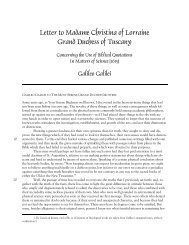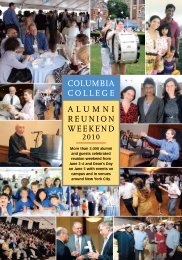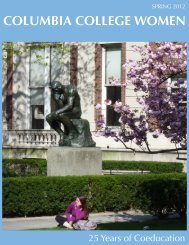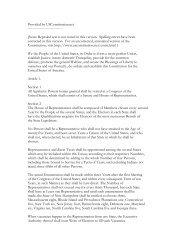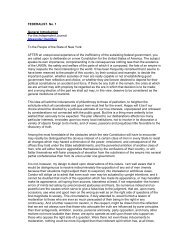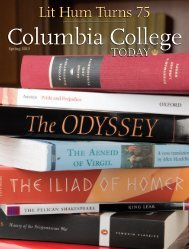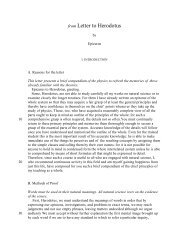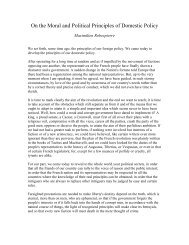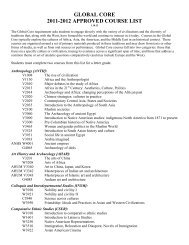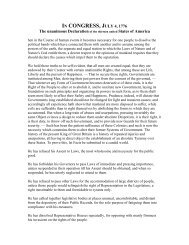Japan Storm - Columbia College - Columbia University
Japan Storm - Columbia College - Columbia University
Japan Storm - Columbia College - Columbia University
Create successful ePaper yourself
Turn your PDF publications into a flip-book with our unique Google optimized e-Paper software.
COLUMBIA COLLEGE TODAY CLASS NOTES<br />
Mark Allen ’71 Guides NASA to Mars Research<br />
It takes nine months for a<br />
spaceship from Earth to<br />
reach Mars, but don’t let<br />
that fool you into thinking<br />
the two planets are really so<br />
far apart. What actually separates<br />
one from the other, says<br />
Mark Allen ’71, is a measly<br />
25 miles; that’s the distance<br />
above Earth where the chemical<br />
and physical composition of<br />
this planet’s atmosphere most<br />
closely resembles that of Mars.<br />
Allen, principal scientist at<br />
the Jet Propulsion Laboratory<br />
(JPL) of the California Institute<br />
of Technology (Caltech) in<br />
Pasadena, is the NASA chief<br />
scientist behind the planned<br />
2016 launch of the ExoMars<br />
Trace Gas Orbiter, a spacecraft<br />
whose mission is to study the<br />
chemical composition of the<br />
Martian atmosphere and to try<br />
to find evidence of primitive<br />
life, or of magma and geothermal<br />
processes, in the planet’s<br />
subsurface.<br />
It is a tremendously ambitious<br />
pursuit –– the first truly<br />
joint planetary mission between<br />
NASA and the European<br />
Space Agency –– and it would,<br />
if successful, herald the first<br />
detection of life or a habitable<br />
region outside of the Earth. All<br />
evidence to date has marked<br />
Mars as a dead planet, both on<br />
its surface and in its interior.<br />
Outcomes aside, though,<br />
for Allen the ExoMars mission<br />
represents something more:<br />
the culmination of a long and<br />
impressive career first formulated<br />
amidst the turbulence of<br />
<strong>Columbia</strong> in the 1960s.<br />
“The story starts with my<br />
entering <strong>Columbia</strong> knowing I<br />
wanted to be a research chemist,”<br />
yet not having much more<br />
than a vague notion of a career,<br />
Allen says. Guided by people<br />
such as physical chemistry<br />
professor George Flynn ’64 GS,<br />
’66 GSAS, “the strong <strong>Columbia</strong><br />
chemistry department allowed<br />
me to see what world-class<br />
research was like” and, with<br />
graduation looming, a scientific<br />
breakthrough in space finally<br />
spawned one of his own.<br />
“In my senior year, I learned<br />
about the discovery of molec ules<br />
in interstellar space (the region<br />
between the stars), an environment<br />
where conventional wisdom<br />
at the time would suggest<br />
that molecules shouldn’t exist,”<br />
he says. “I chose this burgeoning<br />
field of astrochemisry as my<br />
future research interest.”<br />
<strong>Columbia</strong> led to a Ph.D. in<br />
chemistry from Caltech in 1976,<br />
where Allen completed one of<br />
the earliest research papers to<br />
present “model simulations”<br />
of the molecular clouds in<br />
interstellar space, which was<br />
published in 1977.<br />
Not staying away from <strong>Columbia</strong><br />
for long, he returned to<br />
New York for a two-year fellow-<br />
ship at NASA’s Goddard Institute<br />
for Space Studies, a <strong>Columbia</strong><br />
collaborator, where he met<br />
Yuk Yung, a visiting researcher<br />
from Harvard, and Gordon Chin<br />
’70, ’78 GSAS. Both would later<br />
play key roles in shaping Allen’s<br />
career.<br />
In 1978, Yung drew Allen to<br />
return to Caltech as a postdoctoral<br />
fellow in planetary sciences,<br />
preparing him for a move<br />
to JPL in 1981. In the mid-1990s,<br />
Chin resurfaced with a new<br />
opportunity: to jointly develop<br />
B y roBert e. calem ’89J<br />
WINTER 2011–12<br />
75<br />
a mission proposal to NASA for<br />
orbiting Venus and studying the<br />
chemical composition of that<br />
planet’s middle atmosphere,<br />
which bears much resemblance<br />
to Earth’s middle atmosphere.<br />
Although NASA subsequently<br />
did not undertake the<br />
Venus mission, Allen says, the<br />
experience was instrumental in<br />
shaping his work. Building on<br />
that mission proposal, 10 years<br />
Mark Allen ’71 chairs a meeting of the joint European Space Agency/<br />
NASA mission to Mars.<br />
PHOTO: THOMAS (DUTCH) SLAGER<br />
ago he was the first to create<br />
the concept of a Mars trace gas<br />
mission and led a team (including<br />
Chin) to write a new mission<br />
proposal to NASA. Through a<br />
variety of twists and turns, this<br />
proposal gave rise to the Exo-<br />
Mars orbiter project last year.<br />
In hindsight, Allen credits the<br />
<strong>College</strong> for the foundation that<br />
made it all possible. The Core<br />
Curriculum “honed my skills in<br />
articulation of points of view<br />
orally and in writing,” he says,<br />
adding, “I was told by a very<br />
senior JPL program manager<br />
that I prepared the clearest<br />
mission proposals he had ever<br />
read.” Four years on the Ferris<br />
Booth Hall Board of Managers,<br />
of which he was president in<br />
his senior year, taught him leadership<br />
skills that he still uses<br />
today, he says.<br />
Great study habits also con-<br />
tributed to Allen’s successes,<br />
especially in the late 1960s,<br />
when <strong>Columbia</strong> was engulfed<br />
in the societal and political<br />
turmoil of the times.<br />
“We were at <strong>Columbia</strong> during<br />
all the turbulence, [but] he<br />
was a serious science student<br />
and he didn’t let any of that<br />
distract him,” recalls his friend<br />
and dormmate in what was<br />
then known as Livingston Hall,<br />
Richard Fuhrman ’71, a former<br />
member of the <strong>Columbia</strong> <strong>College</strong><br />
Alumni Association Board<br />
of Directors. “He took the industrial-strength<br />
courses, and that’s<br />
frankly what got him to what<br />
he’s doing today. But, despite<br />
the pocket protector, he was<br />
a regular guy who had a sense<br />
of humor. He was very sweet,<br />
very thoughtful.” The two get<br />
together once a year when Allen<br />
returns to Long Island, where he<br />
grew up and Fuhrman now lives,<br />
to visit family and friends.<br />
Allen gives the most credit<br />
to his parents for setting him<br />
in the right direction. “I was<br />
admitted to MIT, but my parents<br />
really didn’t want me to<br />
go because they thought it too<br />
specialized,” he remembers. “I<br />
think they were remarkably on<br />
the ball.”<br />
When it launches in 2016, the<br />
ExoMars orbiter will travel for<br />
nine months to reach the outer<br />
limits of Mars’ atmosphere.<br />
“Aerobraking,” reducing its<br />
orbit radius to where observations<br />
can commence, will add<br />
another seven months. Those<br />
observations, once begun, will<br />
stretch the mission out another<br />
two “Earth years,” Allen says.<br />
“That takes me to [age] 71” and<br />
may make this the last project<br />
he undertakes –– the zenith of a<br />
journey that began in Morningside<br />
Heights and extended to<br />
the heights of outer space.<br />
Robert E. Calem ’89J is a<br />
freelance journalist based in<br />
Hoboken, N.J., who has covered<br />
a wide range of technology<br />
and business subjects for<br />
25 years.




